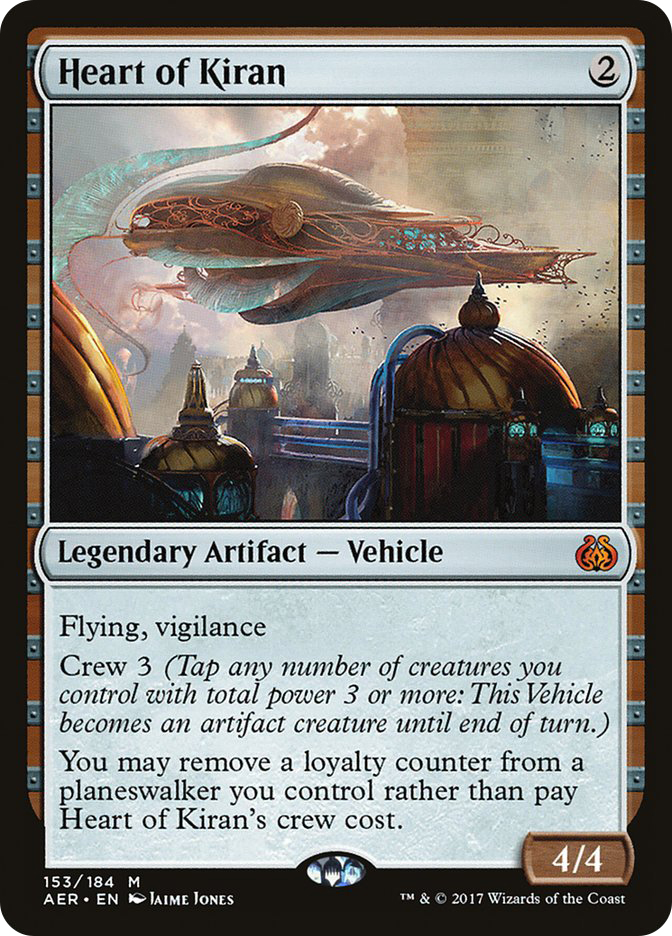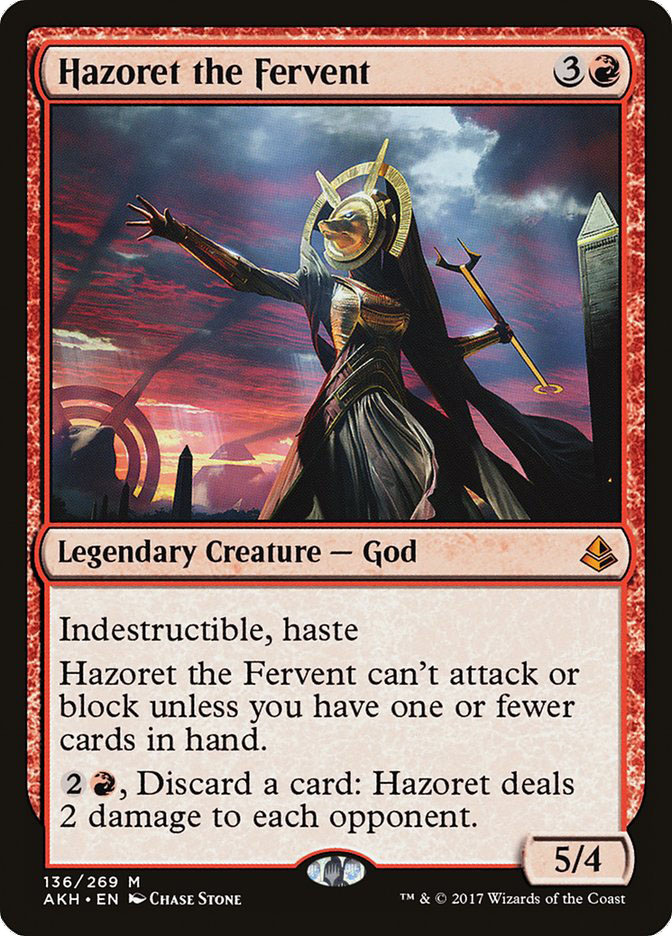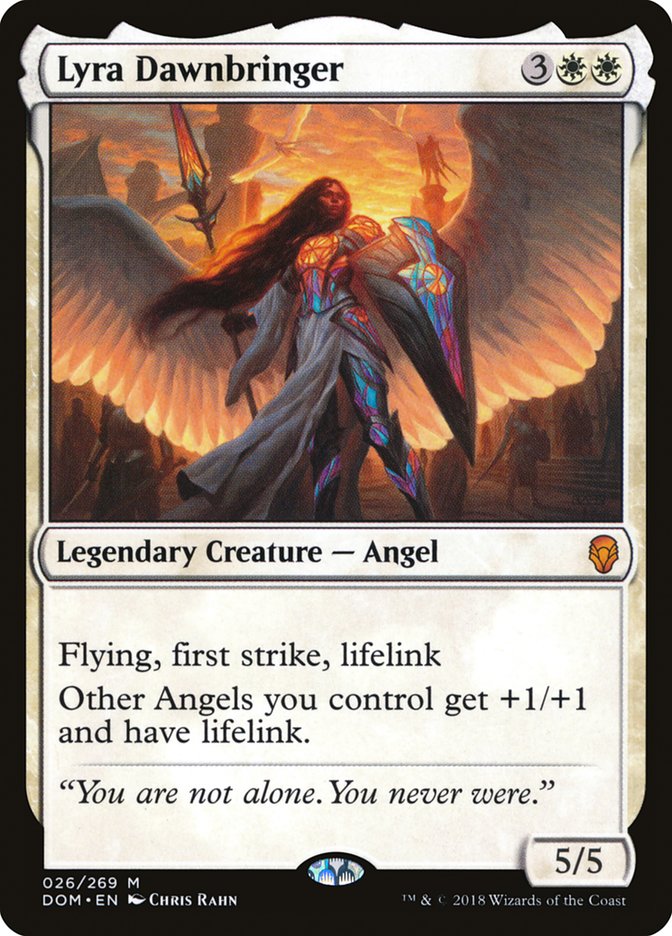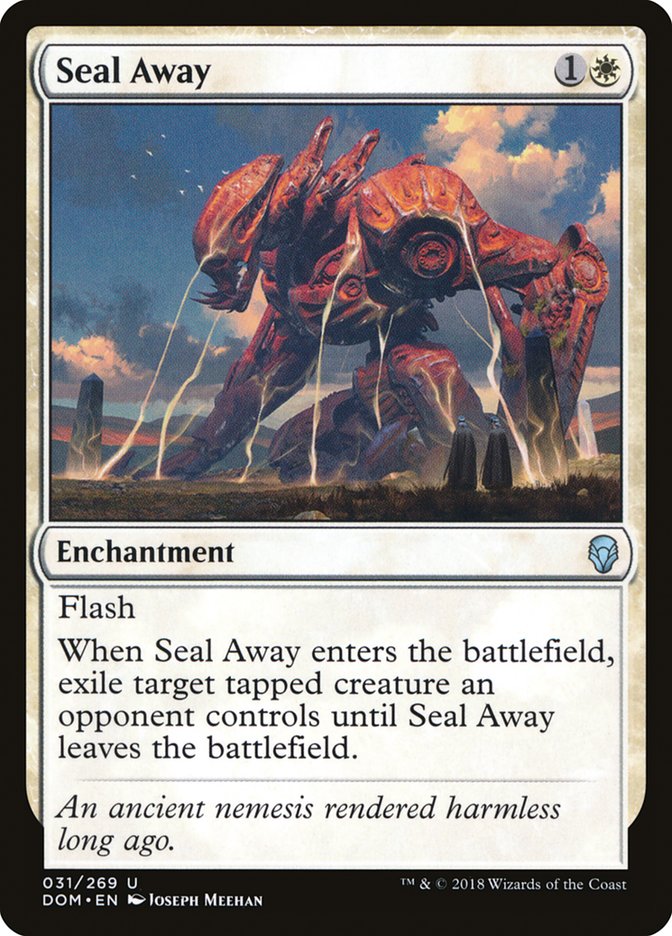I didn’t attend GP Birmingham last weekend because, as it turns out, it was
in England. Had I gone, I would probably have played R/B Aggro. As it
happened, I wasn’t the only one who felt good about the deck’s chances.
Let’s take a look at the top 8:
- Simon Nielsen – R/B Aggro
- Leo Lahonen – U/W Control
- Matt Brown – R/B Aggro
- Martin Juza – R/B Aggro
- Etienne Busson – G/B Constrictor
- Goncalo Pinto – R/B Aggro
- Luke Southworth – R/B Aggro
- Rasmus Nilsson – R/B Aggro
What a smashing. In addition, ten of the remaining 9th-32nd place decklists
were R/B Aggro or a close variant. Note the complete absence of The Scarab
God. The card dominated the last Standard format, but now it’s nowhere to
be seen.
I’m not sure how to feel about these results. On one hand, I’m happy we’re
in a world where Heart of Kiran is great again. I’m going to be very sad
when that thing rotates next September, and I’ll use any justification that
I can think of if it means I can keep crewing it until then. On the other
hand, aggressive decks in general now have a massive target on their
collective back.
How did we get to this spot? Most of the deck has been Standard legal for
over a year now, so why the sudden resurgence? Is Goblin Chainwhirler just
that good? Well yes, it is, but there’s more to it than that. At the end of
the last Standard season, before Dominaria was released, R/B was
already poised to become the deck to beat in Standard. To understand what’s
going on here, we need to turn back the clock a few months…
Last season’s Standard was all about The Scarab God. Many excellent
articles have already been written analyzing The Scarab God’s ability to
dominate the late game, so I won’t rehash that here. Instead I want to
discuss those times when it’s used to stabilize the game. These are the
games where, against an aggro deck, you just decide to ignore their threats
for a turn and cast it. If you untapped with The Scarab God, you were
probably going to win. This play tended to work out pretty well when
Mono-Red Aggro was the premier aggro deck in the format. Your Mono-Red
opponent was often forced to produce an Ahn-Crop Crasher immediately and
hope that you didn’t have a way to kill it before combat. That, or throw
two removal spells at The Scarab God and hope they still had enough gas
left over to kill you.
The efficacy of that line was reduced considerably when R/B Aggro replaced
Mono-Red as the aggro deck to beat. First, R/B Aggro is a bit better at
keeping up the pressure than Mono-Red. R/B has a more diverse package of
threats including Heart of Kiran and Scrapheap Scrounger. These cards
demand specific answers. Sometimes you’re playing Grixis Energy and you’re
facing down a Heart of Kiran. If you draw Abrade or Fatal Push, Heart looks
a lot like any other two-mana creature. Other times you’re stuck with a
Magma Spray in hand or you must make a tough decision about whether to hold
up Vraska’s Contempt and wait for them to crew.
Second, the presence of Unlicensed Disintegration changes everything. It’s
kind of like Ahn-Crop Crasher except that it can’t be interacted with as
easily and generally does three damage, so even drawing it late in the game
is sometimes an out.
So that might explain why The Scarab God is less popular, but it doesn’t
say anything about why vehicles and Unlicensed Disintegration are being
played in the first place. These cards have been only a small part of the
Standard metagame since about April 2017. Why are they back now?
The short answer is Hazoret the Fervent and Mono-Red Aggro in general.
Hazoret generally comes with cheap, aggressive creatures. As I learned
repeatedly after Shadows Over Innistrad rotated, that whole
package matches up well versus Heart of Kiran and Unlicensed
Disintegration. Most of the time, the vehicles player simply can’t afford
to spend three mana to kill any of the small creatures out of Mono-Red,
and, of course, Unlicensed Disintegration itself does nothing against
Hazoret.
There wasn’t a ton of room for vehicles in the metagame at first.
Eventually though, Mono-Red started to get pushed out of the top tables.
There are a few reasons for this. First, the popular B/U and Grixis
midrange and control lists were both even to slight favorites against
Mono-Red. Cheap spot removal, lifelinkers, Whirler Virtuoso, and The Scarab
God can be tough to push through. Additionally, a variety of tokens lists
started showing up. Hazoret tends to look pretty stupid against an endless
supply of chump blockers.
Eventually B/U Midrange and Grixis Energy started to take over some of
Mono-Red’s share of the metagame. Near the end of the season, a new
contender threw its hat into the ring:
Creatures (32)
- 4 Bomat Courier
- 4 Minister of Inquiries
- 2 Trophy Mage
- 4 Walking Ballista
- 4 Combat Celebrant
- 2 Vizier of Many Faces
- 4 Champion of Wits
- 4 Fanatical Firebrand
- 4 Warkite Marauder
Lands (22)
Spells (6)

I played against Grayson on day 1 and was impressed to learn that he made a
sick run on day 2 to make the top 8. He even beat GerryT (playing R/B, of
course) in the semifinals.
It surprised me to find out that this list is actually pretty good against
B/U Midrange. The Scarab God had always been a problem card for previous
iterations of God-Pharaoh’s Gift. After learning a bit more about how U/R
operates, I’m no longer shocked. This version has two big things going for
it. First, their fair game can kill The Scarab God by pairing Warkite
Maurader with either Walking Ballista or Fanatical Firebrand. Second, their
combo is much more explosive than the old U/W lists. Tapping out for The
Scarab God is less appealing when your opponent might just discard their
hand to Bomat Courier, turn on Gate to the Afterlife, and combo you out
with a chain of Combat Celebrants and clones.
Alright, so I’ve talked enough about old Standard. This is a new format and
there are new cards with lots of exciting things to do. Well, okay yes,
that’s true, but the old rules still apply. While I believe there’s still a
lot of space that’s unexplored in Standard, the strategies we’ve seen so
far have only reinforced the narrative that was building at the end of the
last season.
Let’s start at the beginning of the season, SCG Atlanta.
Creatures (4)
Planeswalkers (3)
Lands (26)
Spells (28)

Here we see U/W Control taking over as the control deck of choice, which
makes a lot of sense. It got some powerful new tools in the form of Lyra
Dawnbringer, Seal Away, and of course, Teferi, Hero of Dominaria.
There’s still a lot of R/B Aggro in the top 8, which doesn’t come as a
surprise. After all, it was probably the best deck at the end of the
previous Standard season. It’s also well-positioned against U/R
God-Pharaoh’s Gift. Not an overwhelming favorite or anything as the matchup
is still very losable for R/B (Gerry Thompson proved that). But where many
decks try to race God-Pharaoh’s Gift and cast Abrade on a key turn, R/B has
the additional out to just cast Unlicensed Disintegration on the first
creature returned which is usually good enough to end the game on the spot.
Next, we’ve got a new deck making its debut at SCG Baltimore:
Creatures (16)
Planeswalkers (6)
Lands (24)
Spells (14)
Sideboard

This list is all over the top 8 of the Standard portion of that event.
These W/B Aggro lists showed up at the same time as another innovative list
from the SCG Classic the same weekend.
Creatures (9)
Planeswalkers (5)
Lands (26)
Spells (20)

Collins Mullen’s list is excellent. When I saw it, I was eager to take it
for a spin on Magic Online. I was immediately impressed; the deck is doing
pretty much everything I want to do in Magic right now. The big thing it’s
missing is access to a high density of cheap interaction. That led people
to try to take advantage of that with decks like Mono-Green Aggro.
Creatures (29)
- 4 Llanowar Elves
- 4 Scrapheap Scrounger
- 3 Greenbelt Rampager
- 3 Rhonas the Indomitable
- 4 Merfolk Branchwalker
- 3 Ghalta, Primal Hunger
- 4 Thrashing Brontodon
- 4 Steel Leaf Champion
Lands (23)
Spells (8)

It might not look like it, but W/B Aggro, U/W Historic, and Mono-Green
Aggro were trying to attack the format from a similar angle. What I mean by
that is that they all play either Lyra or Ghalta, both of which have a few
things in common:
-
They both demand immediate answers.
-
Most of the answers available in Standard are somewhat expensive to
cast. -
Neither of them produce any advantage by virtue of entering or
leaving the battlefield.
The way to punish your opponents for playing with threats like these is to
play cheap, unconditional removal. Make your opponent spend four to five
mana on their spell, trade it cleanly for your cheap spell, and play
another threat in the same turn to pull way ahead. If you want to do that
in this Standard format, Unlicensed Disintegration is where you want to be.
Looking Forward
Where do we go from here? I’ll be playing Standard in GP Toronto this
weekend and I’m going to spend this week trying to find a list that matches
up well against R/B Aggro. I’ll be honest; my final product will probably
include both Heart of Kiran and Unlicensed Disintegration with a plan to
beat the mirror. I’m not going to be excited about it, and I’m still
holding out hope that I might find a completely different angle of attack.
It’s hard to know right now exactly what the best way to combat it will be,
but here are some ways to approach the matchup:
Tokens
In particular, History of Benalia matches up really well against R/B. They
don’t want to have to spend removal spells on Knight tokens and the +2/+1
chapter is real. An aggressive build that punishes Heart of Kiran and
Scrapheap Scrounger could be a good place to start. The problem here, of
course, is that you can’t really afford to push the token theme too far
without opening yourself up to getting completely blown out by Goblin
Chainwhirler.
Green Hexproof
When I play R/B, my plan against Winding Constrictor is to kill everything.
I transform into a midrange planeswalker control deck and do everything I
can to keep the battlefield clear. The best cards from the R/B side of the
matchup are Glorybringer and Chandra, Torch of Defiance. Bristling Hydra
throws a gigantic wrench into that plan and is the biggest reason why I
wanted Doomfall in my sideboard last season.
A good way to punish Unlicensed Disintegration is Blossoming Defense. Often
the R/B deck is playing from behind, and a well-timed trick can put the
game out of reach. If I were registering Ghalta next weekend, I’d likely
have four copies of Blossoming Defense in my 75.
Hazoret the Fervent
Decks that want to cast Hazoret can be a real headache for R/B Aggro.
They’re generally fast enough to race Heart of Kiran and Scrapheap
Scrounger. That can put the vehicles player in a tough spot where they
don’t really want to race, but they don’t necessarily want to transform
into a control deck either. They could wind up killing everything only to
end up facing down a Hazoret with no answer. Most lists right now don’t
have a way to interact with the God beyond a few copies of Doomfall and an
Hour of Glory.
Win Mirror Matches
If you decide to sleeve up R/B Aggro this weekend, get some reps in against
the mirror beforehand. Sideboard games are often about who can be a better
midrange deck. Sticking a planeswalker and protecting it is going to be
key. Multiple lists in the top 8 of Grand Prix Birmingham were already
running Release the Gremlins for in their sideboard. Access to that and a
full playset of Abrades is going to be mandatory.
I’m super excited about this Standard format. A performance this dominant
could be a sign that R/B Aggro is too good, but I’m skeptical. Dominaria brought with it a slew of powerful cards. Some of them
have already seen play, but for other, less straightforward designs it will
take time to find the right home. I’m optimistic that we’ll see a diverse
format, and I’m looking forward to seeing what breaks out!







